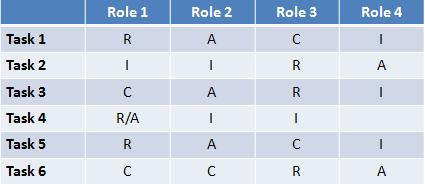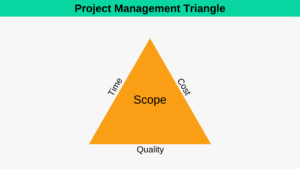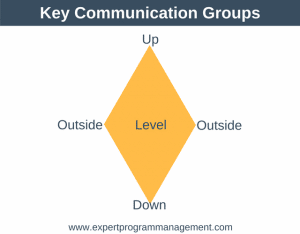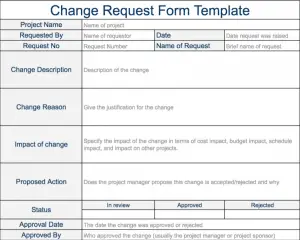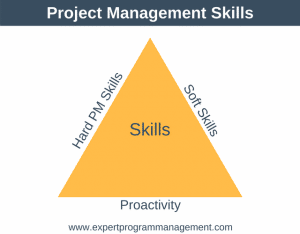The RACI Matrix, sometimes know as the Responsibility Assignment Matrix (RAM) or RACI Model, is a simple tool that is useful for highlighting roles and responsibilities during a project, program, or indeed any organizational change. I first came across the RACI Matrix whilst on an ITIL training course a few years ago and find them particularly useful for clarifying roles and responsibilities in cross-functional or cross-departmental projects spanning a matrix environment.
RACI is an acronym for Responsible, Accountable, Consulted, and Informed. The RACI Matrix enables you to identify who is responsible, accountable, consulted, or informed, for every task which needs to be done on a project.
Here is some more detail about what each letter in the RACI acronym means:
| Responsible | This is the person or role responsible for performing the task, that is, the actual person doing the work to complete the task. |
| Accountable | This is the person who is ultimately accountable for the task being done in a satisfactory manner. Essentially, the Accountable person must sign-off the work that the Responsible person produces. Typically the owner of the process will be the Accountable person. There should only ever be one Accountable person per task. |
| Consulted | Those people whose input is used to complete the task, thus, communication with this group will be 2-way in nature. |
| Informed | Those people who are informed as to the status of the task, thus, communication with this group is 1-way in nature. |
To avoid any confusion as to who is doing what, you should have just one participation type assigned to a given person for each task in the matrix. The exception to this is that sometimes the Accountable person may also be the Responsible person, that is, responsible for completing the task.
RACI Matrix Example
An example of a RACI Matrix is shown below:
There are a number of rules you should keep in mind when creating a RACI matrix:
- Only have one Accountable person. More than one and the task may not get done due to confusion
- Try to limit the number of Responsible persons in a row to one – more than this and there will likely be a duplication of work
- A Responsible person and an Accountable person must be assigned to every row
The above RACI Matrix example what very abstract and theoretical. The RACI Matrix below should give you a more realistic idea of what a RACI Matrix looks like in real life:
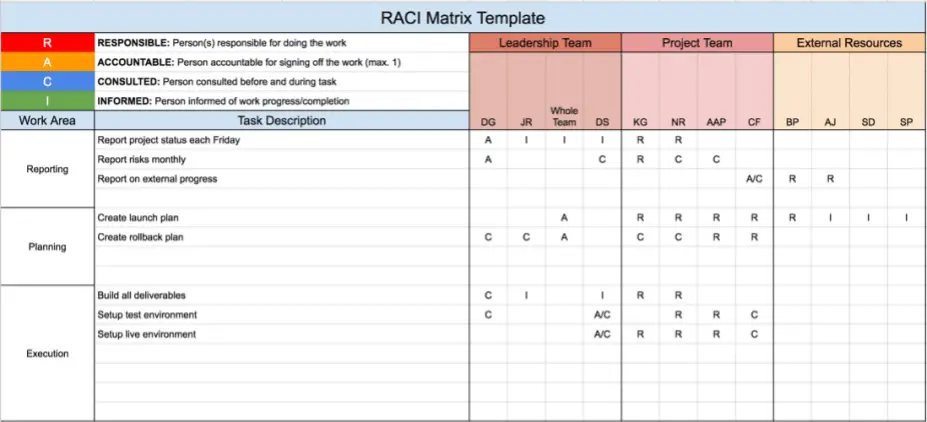
I hope you can see that RACI matrices are simple to create yet especially powerful for clarifying roles and responsibilities across people within different parts of the organization.
If you think about the programs or projects you run, I’m sure you’ll agree that if you don’t spend some time thinking about role that you and your team play in every task which needs to be performed, and clarify this in some way (hint: use a RACI Matrix 🙂 ), then it is likely gaps will appear.
The following visualization can make it much easier to understand how to use the model:
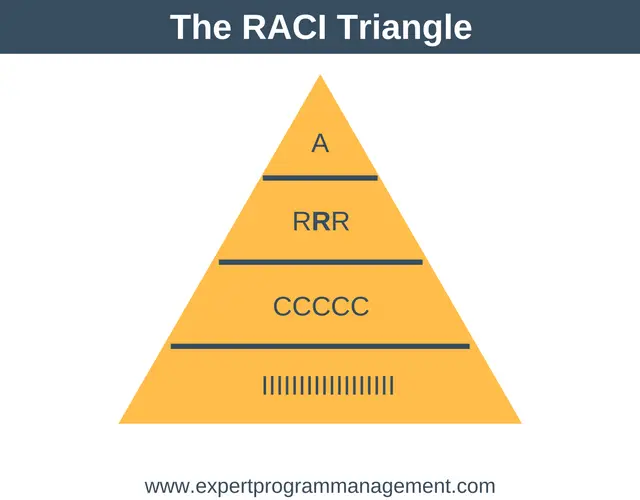
What this visualization shows is that there can be just one accountable person (signing off the work), more than one responsible person (doing the work), potentially multiple people being consulted (giving input), and potentially many people who need to be informed (given status updates etc.).
Pro tip: you can see in the visualization that one R is in bold. It can sometimes be a good idea to use bold to highlight the fact that a single person is responsible for pulling together all the people who are required to complete the task and making sure they do their bit. This way work doesn’t fall down cracks between people and end up incomplete or delayed.
When to Use a RACI Matrix?
The primary function of a RACI Matrix is to connect people to tasks. Basically, a RACI Matrix lets everyone involved in a project or organizational change know exactly what is expected of them on the project, and when people know what’s expected of them it’s more likely they’ll work on the right things and get them done on time. Thus, a RACI matrix is a great tool to use for managing a change project, particularly where functional boundaries are crossed.
If you’re a project manager it would make sense to keep this document as part of your project communication plan.
RACI Matrix Advantages
- They provide clarity about the roles and responsibilities of stakeholders for each task.
- Allows you to ensure that each task has the right roles assigned, as well as allowing you to spot inconsistencies between tasks.
- They avoid the blame game, as everyone is clear on their responsibility level for a given task.
RACI Matrix Disadvantages
- You can’t determine who has overall responsibility for getting a task done, that is, a task can have lots of R’s (hence the Pro Tip above where one of the R’s is bolded).
- They work best in small teams as it can be difficult to explain the RACI concept to larger teams where you’re not all working closely together.
- It can be a mistake to try and capture every single detail in a RACI matrix – you need to experiment to find what works for you based on both your team size and project size.
How to Create RACI Matrix
The steps you need to take in order to create a RACI Matrix are as follows. It is recommended you do this as a group exercise so that agreement on tasks and responsibilities is reached.
- Identify the tasks that need to be done (you might want to use a Work Breakdown Structure to do this) and then list them in the template.
- Identify all stakeholders and add them to the template. This will include:
- Those above you – steering committee, project sponsor etc.
- Those in your immediate project team.
- Those working for the project team internally.
- Interested stakeholders from the wider organization.
- Relevant external stakeholders and third-parties.
- For each task:
- Mark the people who are accountable for completing the work of the task (A).
- Make one person who is responsible (R).
- Mark those people who need to be consulted (C).
- Mark those people who need to be informed (I).
- Distribute the RACI matrix to all stakeholders along with a brief explanation of how to interpret the chart, and request feedback.
- Update the RACI matrix based on the feedback you receive, and sign it off as complete.
RACI Matrix Best Practice
If you’re new to creating RACI Charts then you once you’ve tried to create your first one it can be a good idea to review the following best practice:
- Create the RACI chart with your team to ensure their buy-in.
- Make sure that every task has one and only Accountable.
- Check that those people you’ve marked as Accountable actually have the authority to sign off on the task in question.
- Make sure to distribute the RACI matrix regularly and make updates based on feedback.
- Analyse the RACI matrix to see if people can be optimized:
- Try to push authority down the organization by assigning A’s to the lowest rank people possible.
- Are there people with lots of R’s? Perhaps they have too much work assigned to them. Can this task be given to someone else?
- Analyse the RACI to see if tasks can be optimized:
- Can R’s be removed from a task to enable it to be completed more quickly?
- Too many C’s for a task can slow it down as so many people have to be consulted. Can some of them be removed?
- Too many I’s can create a reporting burden. Is it possible to distribute the plan and then only inform people when something exceptional happens?
Advanced RACI: The RASCI Matrix
By now you should have a really good understanding of how to use a responsibility assignment matrix. There are actually lots of different variations on the RACI Matrix (including PACSI, RASI, RAPID, and RATSI). The most popular is the RASCI Matrix.
As previously mentioned, a big problem with a RACI Matrix is that you can’t determine who has the overall responsibility for getting a task done, as a task can have lots of R’s. A RASCI Matrix solves this problem in a very simple way.
- We assign one and only one R to the person with the overall responsibility for getting the task done.
- We assign zero or more S’s to people supporting the R in getting the task done. Unlike Consulted, S’s help complete the work of the task and report to R for the purpose of the task.
Just as we were able to use a triangle to remember how to use a RACI Matrix, we can use a similar triangle to show us how to use a RASCI matrix:
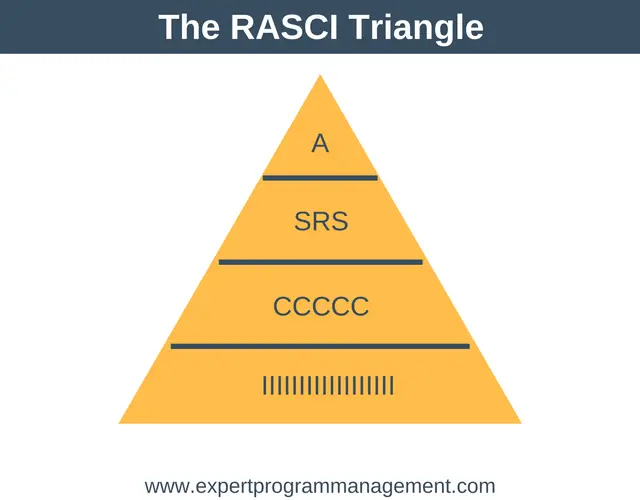
RACI Matrix Template
You can download a free RACI Matrix template here to use in your own projects and adapt to suit your needs.
